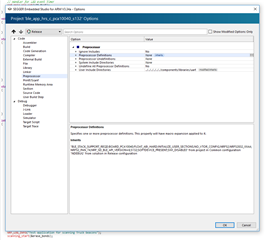

The only file I changed from the given driver files was the common.c file to remove the coines platform utilization (it is not compatible with the nrf chip). Is there any common reason that this could be occuring. I am still using the example code above for reading temp data. If I set these values to a high value, the sensor will read a temp and pressure value but it will never change. The debugging interface looks like this: By default, the application will break in main. Build and program your application to the kit as described in Building and programming a sample application. To set up your environment, you need to download and install.
#Segger embedded studio nordic full#
The d ata ready interrupt, watermark interrupt (on byte level) and FIFO full interrupt are all stuck at ground and never update. Open your project in SEGGER Embedded Studio (SES). FreeRTOS supports Segger Embedded Studio as a development environment for the Nordic nRF52840-DK. I have isolated the issue down to the interrupt signals never reading a high value. This consistently returns succesfully with no errors, but somehow the code still enters the communication error case check.Īny help with this issue would be very appreciated. Ret_code = nrf_drv_twi_rx(&m_twi, dev_addr, reg_data, len) Ret_code = nrf_drv_twi_tx(&m_twi, dev_addr, ®_addr, 1, false) My wrapper function for the coines common.c i2c read function is shown below: BMP3_INTF_RET_TYPE bmp3_i2c_read(uint8_t reg_addr, uint8_t *reg_data, uint32_t len, void *intf_ptr) If (dev->intf_rslt != BMP3_INTF_RET_SUCCESS) This is shown below: elseĭev->intf_rslt = dev->read(reg_addr, reg_data, len, dev->intf_ptr)

In the bmp3.c file, after the data is read through i2c and returns succesfully, the code still enters the communication error if case. I am also running into what I think is another issue. A Serious NRF52840 Application with Bluetooth To move on to a more serious application, the best thing to do is start with a Nordic-supplied. I have force enabled the value but this only reads static values. 3.1 Hardware Selection and Software Configuration The hardware used for this experiment were two Nordic nRF 52840 PDK. Segger Embedded Studio Piece showing Hello World. If you are using a SEGGER Embedded Studio (SES) project from nRF5 SDK v14.2.0 or later, the placement of the SoftDevice is already configured correctly and you can skip this step. I am running into an issue where the value is never enabled. I am currently trying to run the read_sensor_data example. Additionally I have intgreated the COINES common.c, and common.h libraries into the enviroment so I can use Bosch's starter code and examples. I am using segger embedded studio, as well as the Bosch libraries (bmp3.c, bmp3.h, bmp3_defs.h). I am trying to get sensor readings from the BMP384 on a Nordic NRF52 chip.


 0 kommentar(er)
0 kommentar(er)
